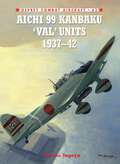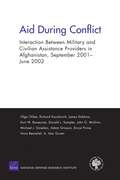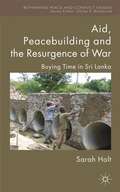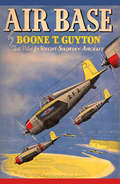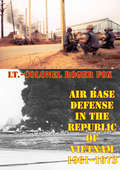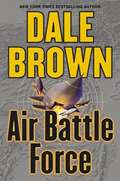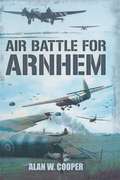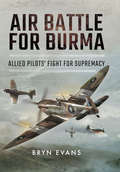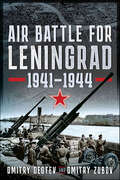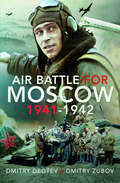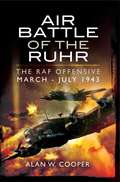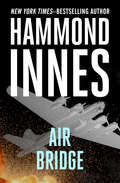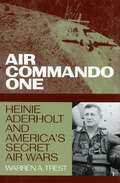- Table View
- List View
Ah, Treachery!
by Ross ThomasAh, Treachery!, the last novel Thomas wrote before his death, tells the story of one Captain Edd "Twodees" Partain, drummed out of the Army and hounded by rumors of his involvement in a secret operation in El Salvador. Twodees gets hired on to help a fundraiser for the "Little Rock folks" recover funds that were stolen from an illicit stash used to smooth over problems and pay off hush money. Meanwhile, Partain is involved in a storefront operation called VOMIT (Victims of Military Intelligence Treachery) trying to defend former intelligence operatives such as Partain from those who are trying to cover up the past permanently.
Ahora que cae la niebla
by Oscar VelaLa asombrosa historia de Manuel Antonio Muñoz Borrero, cónsul ecuatoriano en Estocolmo, que durante la Segunda Guerra Mundial salvó la vida de cientos de familias judías. Ahora que cae la niebla es la biografía novelada de Manuel Antonio Muñoz Borrero, cónsul de Ecuador en Estocolmo entre 1935 y 1942; un hombre que decidió guardar un secreto hasta la muerte, y que recientemente se convirtió en héroe. Con una combinación sorprendente de ficción y de realidad, Óscar Vela consigue trazar el retrato de un personaje que desde su posición privilegiada de diplomático se la jugó para salvar a cientos de familias judías durante la Segunda Guerra Mundial. El suspenso, la aventura y una conmovedora historia de amor, son los motores de esta narración de guerra, que por encima de todo pone en evidencia la valentía de un hombre que representa a todos aquellos que hasta hoy siguen arriesgando su vida por la libertad de los demás.
Ai! Pedrito! When Intelligence Goes Wrong
by Kevin J. Anderson L. Ron HubbardA rollicking and unpredictable adventure through the world of spies and double agents, lovers and enemies (often one and same). It has been said that somewhere in the world you have an exact double. This rocket-ride of a novel ignites with the sudden cry of "Ai! Pedrito!", as Naval Lieutenant Tom Smith discovers that his exact look-alike is the notorious South American revolutionary and spy, Pedrito Miraflores. Inspired by a real incident in the life of L. Ron Hubbard, "Ai! Pedrito!" is a fun-to-read, compelling novel of what can sometimes happen when intelligence goes wrong. "All the fast pacing of James Bond and the adventure of Indiana Jones." --Mystery Scene
Aichi 99 Kanbaku 'Val' Units
by Jim Laurier Osamu TagayaThe Aichi Type 99 Carrier Bomber (D3A) - code named 'Val' by Allied intelligence - was the mainstay of the Imperial Japanese Navy's carrier dive-bomber force from 1941 to 1943. It sank more Allied warship tonnage than any other Axis aircraft during World War II (1939-1945). While the Val's participation in the major carrier battles has been widely covered in other English language sources, details of its operations have received scant attention in English. This book explores the Val's combat operations. Colour illustrations and photographs complement the development of dive-bombing methods in the IJN.
Aid During Conflict: Interaction Between Military and Civilian Assistance Providers in Afghanistan, September 2001-June 2002
by Olga Oliker James Dobbins Kurt W. Basseuner Donald L. Sampler Richard KauzlarichDescription and evaluation of relief, reconstruction, humanitarian, and humanitarian-type aid efforts in Afghanistan during the most intense phase of military operations, from September 2001 to June 2002. The efforts were generally successful, but there were serious coordination problems among the various civilian and military aid providers. Critical issues, both positive and negative, are identified, and a list of recommendations is provided for policymakers, implementers, and aid providers, based on lessons learned.
Aid for Elites
by Mark MoyarCurrent foreign aid programs are failing because they are based upon flawed assumptions about how countries develop. They attempt to achieve development without first achieving good governance and security, which are essential prerequisites for sustainable development. In focusing on the poorer members of society, they neglect the elites upon whose leadership the quality of governance and security depends. By downplaying the relevance of cultural factors to development, they avoid altering cultural characteristics that account for most of the weaknesses of elites in poor nations. Drawing on a wealth of examples from around the world, the author shows that foreign aid can be made much more effective by focusing it on human capital development. Training, education, and other forms of assistance can confer both skills and cultural attributes on current and future leaders, especially those responsible for security and governance.
Aid, Peacebuilding and the Resurgence of War
by Sarah HoltAs one of South Asia's oldest democracies Sri Lanka is a critical case to examine the limits of a liberal peace, peacebuilding and external engagement in the settlement of civil wars. Based on nine years of research, and more than 100 interviews with those affected by the war, NGOs, and local and international elites engaged in the peace process.
Aiming at Targets: The Autobiography of Robert C. Seamans Jr.
by Roger C. Seamans Jr.An essential volume in the NASA History Series by Robert C. Seamans, Jr., the Associate Administrator of NASA during the Apollo program. A stirring insider’s account of NASA and the manned space program at the highest levels. Relationships with the Department of Defense, the Apollo 204 fire, the assassination of President Kennedy, and more.Aiming at Targets is a series of fascinating topical vignettes covering the author’s professional life. Taken together, like broad brushstrokes in an impressionist painting, they give a better picture of Bob Seamans and his work than a detailed recitation of facts and dates could hope to do. This is a cheerful account of an interesting and successful career. The book is full of good stories, with many memorable characters. Like the proverbial sundial, it counts the sunny hours.
Air Apaches: The True Story of the 345th Bomb Group and Its Low, Fast, and Deadly Missions in World War II
by Jay A. StoutThe American 345th Bomb Group--the Air Apaches--was legendary in the war against Japan. The first fully trained and fully equipped group sent to the South Pacific, the 345th racked up a devastating score against the enemy. Armed to the teeth with machine guns and fragmentation bombs, and flying their B-25s at impossibly low altitudes--often below fifty feet--the pilots and air crews strafed and bombed enemy installations and shipping with a fury that helped cripple Japan. One of the sharpest tools in the U.S. arsenal, the 345th performed essential missions during Gen. Douglas MacArthur&’s campaigns in New Guinea and the Philippines, earning an impressive four Distinguished Unit Citations.This was punishingly dangerous work, and the 345th lost 177 aircraft and 712 men--young men doing their duty in the spirit of the Greatest Generation. Neither was this the more gentlemanly war of Europe, with its more temperate climate, resistance networks aiding downed crews, and POW camps. Airmen shot down in the Pacific theater faced drowning in the ocean, disappearing in the jungle, or torturing and beheading by the Japanese in a war of no quarter expected, no quarter given.A compelling follow-up to Jay A. Stout&’s Hell&’s Angels, Air Apaches reconstructs the missions of the 345th Bomb Group in striking detail, with laser focus on the men who manned the cockpits, navigated the B-25s, dropped the bombs, serviced the planes, and helped win the war. To tell this remarkable story, Stout worked closely with the group&’s surviving veterans and dug deep into firsthand accounts. The result is a compelling narrative of men at war that will keep readers on the edge of their seats.
Air Base
by Boone GuytonAir Base, first published in 1941, by aviator Boone Guyton, is a fascinating look at the U.S. Navy's flying fleet shortly before Pearl Harbor and America's entry into the Second World War. In a style ranging from amusing to tragic and harrowing, Guyton describes his experiences as a Navy flyer. Following a year of flight-training at Pensacola, Guyton is based in San Diego with a carrier squadron aboard the Lexington and Saratoga. He describes the training cruises of the ship, the patrol flights, dive bombers, and war games, providing insight into the prewar Navy air force. Included are 8 pages of photographs. Following his naval service, Boone Guyton (1913-1996) worked as a test pilot in France until 1940. He returned to the U.S. and continued his work as a test pilot for Vought with the F4 Corsair. Following the war, Guyton settled in Connecticut and continued working as an executive for several aviation companies.
Air Base Defense In The Republic Of Vietnam 1961-1973 [Illustrated Edition]
by Lt.-Colonel Roger P. FoxIncludes 78 photos and 16 maps / chartsThis book explores the unique problem of defending air bases during the Vietnam War. It centers on the primary efforts of the United States Air Force and allied air units to defend 10 key air bases within the Republic of Vietnam. Bien Hoa, on 1 November 1964, was the first base to be attacked and until the cease-fire in January 1973, these bases suffered a total of 475 attacks.Although there were initial deficiencies in staff support for base defense in such key areas as intelligence, motor vehicles, weapons procurement and maintenance, communications, and civil engineering, significant improvements had been made by the end of the Air Force's part in the war.The author, Lt. Col. Roger P. Fox, USAF (Ret.), wrote this volume while assigned to the Office of Air Force History. He brings judgments to his research based on his personal experience as a base security officer during the conflict. Thus, early on the morning of 4 December 1966, he rallied Air Force and South Vietnamese security forces to repel an enemy attempt to penetrate Tan Son Nhut Air Base, the center of Air Force operations in South Vietnam. For his gallantry in action on this occasion, he was awarded the Silver Star. This personal experience formed a foundation upon which he developed a keen insight into exploring the entire spectrum of air base defense, and upon which he has built a strong case for testing future plans and operations.
Air Battle Force (Patrick McLanahan #11)
by Dale BrownIn military circles it's known as Air Battle Force -- an air combat unit of the future, under the command of aerialwarfare expert Major General Patrick McLanahan,capable of launching stealthy, precision-guidedfirepower to anywhere on the globe within hours. And now McLanahan and his warriors have their first target.Driven from Afghanistan, the parasitic forces of the deposed Taliban regime have decided to feed on a new host -- an isolated, oil-rich Central Asian neighbor that's ripe for the conquering. The battle for control of the world's largest oil deposits has begun, with unsteady alliances forming and opposing forces set to collide. And now a handful of American commandos half a world away, aided by McLanahan's unproven robotic warplanes, will have to triumph against overwhelming numbers in a war that nobody -- including "friendly" forces at home -- wants them to win.
Air Battle for Arnhem
by Alan W. CooperOver sixty years ago a battle took place that, if it had succeeded, could have shortened the Second World war by six months. The operation to take the bridges at Arnhem was given the code name 'Operation Market Garden', Market being the air side of the operation and Garden the subsequent ground operation. The main problem was communications between the ground forces and the re-supply aircraft of the Royal Air Force.Its their efforts and the courage on evident display at Arnhem that the book is based upon. Over a period of seven days troops of the 1st Airborne were taken by the RAF in towed gliders and then in subsequent days showed courage of the highest order to make sure that the ground troops were supplied with ammunition and food to sustain them in their efforts to take the bridges at Arnhem. Their efforts were costly, 309 aircrew and 79 Air Dispatchers were killed and 107 aircraft, which included the men and aircraft who supported the main re-supply armada.One of the re-supply aircraft, flown by F/Lt David Lord DFC, was shot down. Lord was later awarded the Victoria Cross. His courage and dedication are exemplary of the efforts of the men of Transport Command to make sure the men on the ground were re-supplied. The men of the Air Dispatchers, or AD's as they were known, must always be remembered when regarding Arnhem. Their efforts to make sure the supplies were released from the aircraft, and on to the besieged men on the ground, was a vital factor in getting vital supplies to the troops successfully.This is their story, vividly told, and serves a commemorative purpose, memorialising both the events and, most importantly, the men who participated.
Air Battle for Burma: Allied Pilots' Fight for Supremacy
by Bryn EvansAfter a long series of crushing defeats by the apparently unstoppable Japanese air and ground forces, the eventual fight back and victory in Burma was achieved as a result of the exercise of unprecedented combined services cooperation and operations. Crucial to this was the Allies supremacy in the air coupled with their ground/air support strategy.Using veterans firsthand accounts, Air Battle For Burma reveals the decisive nature of Allied air power in inflicting the first major defeat on the Japanese Army in the Second World War. Newly equipped Spitfire fighter squadrons made the crucial difference at the turning point battles of the Admin Box, Imphal and Kohima in 1944. Air superiority allowed Allied air forces to deploy and supply Allied ground troops on the front line and raids deep into enemy territory with relative impunity; revolutionary tactics never before attempted on such a scale.By covering both the strategic and tactical angles, through these previously unpublished personal accounts, this fine book is a fitting and overdue tribute to Allied air forces contribution to victory in Burma.
Air Battle for Dunkirk, 26 May–3 June 1940: 26 May - 3 June 1940
by Norman FranksA gripping account of the Royal Air Force&’s daring exploits during the heroic evacuation of Allied troops from France in World War II. &“Where is the RAF?&” was the oft-quoted question asked by soldiers waiting on the beach at Dunkirk, to where they had retreated following the German blitzkrieg through northern France, and where they were now being pounded by the Luftwaffe. The air forces were there, as Norman Franks proves, detailing the outstanding achievements of the Allied pilots who fought, using outmoded tactics, against enemy pilots who had earlier had easy victories over the Polish, Dutch and Belgian air forces. The RAF&’s achievement reminds us just how close Britain came to disaster in June 1940. &“An absorbing read, which vindicates the RAF.&” —RAF Historical Journal &“Leveraging mission logs and splicing firsthand written accounts, the narrative is both cohesive and seamless. The details are incredibly rich, yet not burdensome.&” —Air & Space Power Journal &“With the recent release of the blockbuster film on the same subject, Franks&’ recounting of the air battle for Dunkirk is timely for those who left the movie theater wanting more . . . Air Battle for Dunkirk is recommended for those who loved the film and wanted more context. This book is especially recommended for those who are interested in aviation history.&” —Nicole Granados, Picture This Post
Air Battle for Leningrad: 1941–1944
by Dmitry Degtev Dmitry ZubovThis book examines the full story of the German and Soviet aerial battles in the Leningrad sector during the siege. The Siege of Leningrad was one of the most brutal battles of the Second World War. The second largest and most populous city in the Soviet Union, Leningrad, now St. Petersburg, was one of the three priority targets of the German invasion, Operation Barbarossa. A total of 333 large military factories were concentrated in Leningrad and, accordingly, 565,000 workers lived there, producing tanks, aircraft, artillery and warships. On 10 July 1941, German tank divisions, having broken through the front south of the city of Pskov, reached the town of Luga. From there, Hitler’s forces had just over 110 miles to go to Leningrad. Meanwhile, the city was feverishly preparing for defense. Stalin’s deputies, Zhdanov and Voroshilov, planned to use the entire combat-ready population of Leningrad for that purpose. Believing that the city would soon be captured by the Germans, Stalin ordered the immediate evacuation of military factories and skilled workers from Leningrad to the East. Before the city was completely blockaded, most of the valuable equipment had been removed. However, the remaining civilian population, including about 400,000 children, were left to their fate. In early September 1941, German divisions supported by the Luftwaffe’s VIII Fliegerkorps, captured the town of Shlisselburg. Leningrad was now cut off from the rest of the Soviet Union. Hitler believed that the city would soon echo to the sound of German jackboots. Leningrad, however, did not give up. In the autumn of 1941, the Wehrmacht did not have enough forces to take the city and for three long years the main means of fighting its defenders were the Luftwaffe and long-range artillery. In September 1941, when the systematic bombing and shelling began, many thousands of families tried to leave Leningrad, but nearly all of the escape routes were cut off. Food supplies in the city sharply decreased. In this book the authors explore the full story of the German and Soviet aerial battles in the Leningrad sector during the siege. There are devastating details of the bombing of the starving population, numerous attempts by the Luftwaffe to destroy the Red Baltic Fleet, and air attacks against the ‘Road of Life’, along which vital food and ammunition were delivered to the city, and combats in the skies over Leningrad and its surroundings. Revealing what was happening in the air and on the ground, as well as in the German and Russian headquarters, the authors explain why, in spite of numerous successes, the Luftwaffe failed to help force the surrender of Leningrad.
Air Battle for Moscow 1941–1942
by Dmitry Degtev Dmitry ZubovThis is the story of the aerial element of the Battle for Moscow between 1941 and 1942, known to the Germans as Operation Typhoon.In October 1941, Operation Typhoon and the battle for Moscow began. According to Hitler's plan, it was to be the ‘last offensive’, after which nothing could stop Germany from conquering Britain and the rest of Europe – but first he had to overcome the Soviets and especially their air force. Air Battle for Moscow is the first detailed description of one of the most vital, yet little known, air battles of the Second World War. The battle for Moscow opened with the flights of long-range reconnaissance aircraft, which photographed Moscow and the Kremlin. Then, on 22 July 1941, Operation Clara Zetkin, the Luftwaffe’s aerial assault on Moscow, began. But the Luftwaffe was opposed by the ‘Stalin's Falcons’, the elite 6th Air Defence Corps, which defended the Soviet capital with a determination which saw bitter duels to the death and horrendous casualties on both sides. The book presents new facts about this dramatic battle and describes in detail the actions of the aircrew on both sides. Yet this is not just the story or the air war. The authors also describe the lives of people during the war, of suppressed anti-Soviet opposition in Moscow, and of the bloodthirsty and inhuman actions of the Stalin regime. The book also tells of the fate of German pilots caught in Russian captivity, and the adventures of those who were able to survive and escape from the Russian executioners. Many myths concerning the battle are also challenged, such as the often-stated belief that Moscow’s anti-aircraft defenses were the most powerful in the world and that it was the Soviets who were the finest pilots. In this comprehensive account, details of losses, biographical outlines of the key individuals, analyses of the different aircraft and a full chronology of the battle are presented, as well as numerous exclusive photos, documents and drawings. But it is the stories of those who fought in the Battle for Moscow that, undeniably, have the greatest impact. The harrowing tales of death and survival in conditions that are almost beyond description demonstrate just how important this conflict was to both Russia and the Third Reich and, ultimately, to the outcome of the Second World War.
Air Battle of Malta: Aircraft Losses and Crash Sites, 1940–1942
by Anthony RogersIn the Second World War, Malta was besieged for nearly two and a half years, during which time a decisive air war was waged between Britain, Italy and Germany.This is part of that story, from the early days in June 1940, when only a few Gladiator biplanes were available to combat Italian bombers and fighters, to the intervention of the Luftwaffe and the tenuous defense by outclassed Hurricanes, culminating in the desperate months of fighting following the arrival on Malta of the Spitfire in March 1942.What became of the many aircraft destroyed over the Maltese Islands, and what was the fate of their pilots and crews?More than a thousand aircraft were lost. Many crashed into the Mediterranean; others came down on Malta and the neighboring island of Gozo. This book focuses on the latter some 200 British, Italian and German machines, and the fate of their pilots and crews. It reveals where those airplanes fell, thus providing a record that will continue to be valued by future generations.This comprehensive volume documents all known aircraft crash sites in and around the Maltese Islands and provides the circumstances of each loss are related in detail with accounts from both sides.In Germany especially there are many still unaware of the fate of family members who never returned after the Second World War. This book reveals what happened to some who even today are still officially listed as missing.
Air Battle of the Ruhr: The RAF Offensive March–July 1943
by Alan W. CooperFirst published to acclaim in 1992, this book deals with the exploits of Bomber Command during their offensive against German Industry in the Ruhr during World War II. The author begins by describing the role of Bomber Command and goes on to define the Ruhr area and its great importance in terms of industrial output to the Germans. The author provides the statistics for bombers dispatched, the number, which actually got to the targets and those, which never made it for one reason or another. Air Battle of the Ruhr is a complete overview of a major aspect of the air war against mainland Germany a subject that has rarely been dealt with in such depth. This book fills in an important gap in the history of the Royal Air Force.
Air Battles Before D-Day: How Allied Airmen Crippled the Luftwaffe and German Army in France
by Joseph T. Molyson Jr.From the skies above Europe to the beaches of Normandy, the Allied air campaign of 1943-44 orchestrated one of history's most decisive military victories. In this groundbreaking analysis, retired Air Force Colonel Joseph T. Molyson reveals how a year of strategic bombing and aerial warfare created the conditions necessary for D-Day's success. Drawing on his thirty years of military intelligence experience, Molyson pieces together the complex puzzle of amphibious planning, airborne operations, and inter-Allied coordination that culminated in Operation Overlord. Key revelations include: How the Allied victory in the Battle of the Atlantic enabled the crucial flow of American resources The strategic bombing campaign's dual role in weakening both German industry and Luftwaffe capabilities The intricate coordination between British night raids and American daylight bombing missions Previously overlooked connections between air superiority and the success of the D-Day landings Perfect for military history enthusiasts and World War II scholars alike, this meticulously researched account offers fresh insights into the aerial strategy that changed the course of history.
Air Bridge: Isvik, Air Bridge, Atlantic Fury, And Levkas Man
by Hammond InnesA daredevil pilot joins the Berlin Airlift to fight for democracy in this Cold War adventure from &“a whale of a writer&” (The New York Times). When his plane goes down over Germany, Neil Fraser vows not to die in a POW camp. He tunnels out beneath the barbed wire, commandeers a Messerschmitt fighter plane, and flies it home to England. He&’s been stealing planes ever since. After the war, Fraser falls in with an international ring of thieves, lifting planes from England and flying them to the land that will soon be known as Israel. But his luck doesn&’t last. The owner of a charter company catches Fraser in the act and gives him a simple choice: Work for him, or rot in jail. His new boss, Bill Saeton, a ruthless tycoon with dreams of conquering the sky, has a contract that could make his fortune—if only he can get his newest plane into the air. Together, Saeton and Fraser embark on the most astonishing adventure of the Cold War: flying in the skyborne armada of the Berlin Airlift, to live or die in the skies above a divided Germany. Authored by Hammond Innes, who witnessed the Berlin Airlift firsthand, Air Bridge is the incredible story of the men who fought impossible odds to win one of the most crucial battles of the Cold War.
Air Campaigns: Fact Or Fantasy?
by Major Mark H. SkattumThis monograph addresses the concept of air operations and their relationship to campaigns. It determines whether air actions should be considered as operations or campaigns. The monograph first addresses the definitions of the terms "campaign" and "operation," and then establishes the criteria by which to judge three historical examples of the use of air power. These examples are the Battle of Britain, the Korean War air interdiction battle, and the Israeli pre-emptive strike against the Egyptian Air Force during the 1967 Arab-Israeli war.The monograph concludes that air operations should not be considered as campaigns. Air operations are part of the overall campaign and support campaign objectives rather than accomplishing strategic goals. The implications of this analysis are that air superiority should be the primary air operation; offensive air and ground operations must be synchronized for success; and the terms and concepts applied to ground operations can be applied to air operations. By understanding the correct relationship between air operations and campaigns, air planners can help Army planners prepare for success on the joint battlefield.
Air Combat 1945: The Aircraft of World War II's Final Year (Stackpole Military Photo Series)
by Donald NijboerA detailed and fully illustrated look at aerial combat in the closing year of WWII across all theaters of conflict. The final year of World War II witnessed the decline of the piston-engine fighter and the beginning of the jet age. Taking to the skies were tried-and-true fighters, improved versions of old aircraft, and newly developed jets, including prototypes that flew for the first time just before the war ended. In Air Combat 1945, historian Donald Nijboer examines these dynamic aircraft through hundreds of wartime photographs depicting operations across Europe, the Mediterranean, and the Pacific. This volume covers American Mustangs, Thunderbolts, and Shooting Stars; British Tempests, Spitfires, and Gloster Meteors; German Fw 190s, Bf 109Ks, and Messerschmitt Me 262s; Japanese Ki 100s, Raidens, and Tojos; and many more.
Air Combat: A History of Fighter Pilots
by Robert F. DorrIn Air Combat, veteran and military author Robert F. Dorr has collected dozens of interviews from combat veterans who have faced the enemy in the skies above-from the first days of World War II to the current war on terror. Each story offers a firsthand account of what it's like to be in the thick of the fight, describes the history, strengths, and weaknesses of each man's plane in detail, and offers readers a rare glimpse into the minds and hearts of those who dare to fight in the air.
Air Commando One
by Warren A. TrestAir-dropping agents deep behind enemy lines in clandestine night missions during the Korean War, commanding secret flights into Tibet in 1960 to support the anticommunist guerilla uprising, participating in plans for the 1962 Bay of Pigs invasion--even before the escalation of the Vietnam War, Brigadier General Harry C. "Heinie" Aderholt worked at the heart of both the U.S. Air Force and CIA special operations worldwide. In 1964 he became commander of the famed First Air Commando Wing, fighting to build up special operations capabilities among the American and South Vietnamese airmen. In 1966 and 1967 he and his men set the record for interdicting the flow of enemy trucks over the Ho Chi Minh Trail in Laos and North Vietnam.Drawing on official records, personal papers, and interviews with Aderholt and many who worked with him, Air Force historian Warren A. Trest details the life and career of this charismatic, unconventional military leader who has become a legend of the Cold War Air Force. He tells how Aderholt's vigorous support of low-flying, propeller-driven aircraft and nonnuclear munitions pitted him against his superiors, who were steeped in doctrines of massive retaliation and "higher and faster" tactical air power. In the mid-1960s Aderholt's clash with Seventh Air Force Commander General William W. Momyer reflected a schism that still exists between the traditional Air Force and its unconventional special operations wings. The book also integrates U.S. Air Force and CIA accounts of some of the most pivotal events of the past fifty years.



